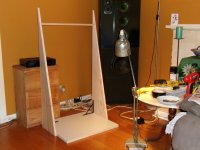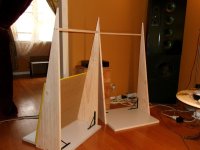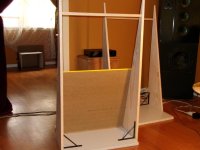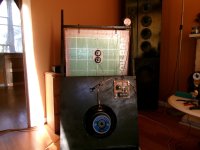Tape tends to damp the high frequencies above 10k.
Pva, takes about 4 or 5 days before the hf above 10k starts to improve.
Depending on temperature and material glued to.
Steve.
Pva, takes about 4 or 5 days before the hf above 10k starts to improve.
Depending on temperature and material glued to.
Steve.
No problem, the data were in the table.Christian,
I should have said that the frequency is cut in half, rather than doubles.
Eric
In the seach of "cavity noise": step 1, beware of the spine!
In the past days, I was surprised how my measurements from the rear side may differ from the ones from Eric. So I made new measurements in the idea to have more flexibility on change at the rear in order to understand why those differences and of course to try to find a cause of the difference of the front and rear frequency responses.
From those tests, it comes something that is pretty obvious afterwards : the spine can be the main cause of the difference in SPL between the front and the rear.
Below are the FR of the tests done. There are some pictures to show the set up and the curves are the difference of rear frequency responses with the test spine and without (not smoothed difference and 1/6 of octave smoothed)
The widest the spine, the highest the peak and not by few dB!
Even a spine of about 10mm width creates peaks and dips of several dB.
I didn't have the possibility during those tests to evaluate the influence of the shape (round edges) and the distance from the exciter.
Of course more tests to confirm or not are welcome!
Note that without spine, a difference front to rear not shown here remains.
But if so... what about... to follow in a next post.
Christian



In the past days, I was surprised how my measurements from the rear side may differ from the ones from Eric. So I made new measurements in the idea to have more flexibility on change at the rear in order to understand why those differences and of course to try to find a cause of the difference of the front and rear frequency responses.
From those tests, it comes something that is pretty obvious afterwards : the spine can be the main cause of the difference in SPL between the front and the rear.
Below are the FR of the tests done. There are some pictures to show the set up and the curves are the difference of rear frequency responses with the test spine and without (not smoothed difference and 1/6 of octave smoothed)
The widest the spine, the highest the peak and not by few dB!
Even a spine of about 10mm width creates peaks and dips of several dB.
I didn't have the possibility during those tests to evaluate the influence of the shape (round edges) and the distance from the exciter.
Of course more tests to confirm or not are welcome!
Note that without spine, a difference front to rear not shown here remains.
But if so... what about... to follow in a next post.
Christian
In the seach of "cavity noise": step 2, end of the tree that hid the forest?
But if a spine can significantly change the FR of the rear... what about the mask effect of the exciter itself?
Below are 2 panels I just tested. The idea is to measure the front side, the rear side (of course without spine, just the exciter) and again the front with at the exciter axis, at some mm a mask having the shape of the exciter (about 50mm for a DAEX25FHE)... and it seems to create artifacts similar to what happens at the rear.
Not highly precise neither highly scientific but it seems to show interesting things that the trials to reduce the compression of the air in the voice coil area haven't shown for now.
This doesn't mean the cavity noise is not another source of peaks at the rear (in the 5 to 6k range?
The first panel below is a plywood where the exciter was mounted on a sort of tripod. The idea was to allow the air to flow through it while keeping an interface on a disk of 20/22mm (larger than the previous concentrator I tested). This panel as with the previous concentrator shows many spikes in the IR. So no good news on the concentrator topic.
The second panel is an XPS (Depron 9mm). The exciter is PVA glued on its ring. The drum effect is huge!
Conclusion? Part of the rear SPL difference might come the mask created by the exciter itself which would increase the difficulty to find a countermeasure
Christian
Plywood 2mm

Depron 9mm

But if a spine can significantly change the FR of the rear... what about the mask effect of the exciter itself?
Below are 2 panels I just tested. The idea is to measure the front side, the rear side (of course without spine, just the exciter) and again the front with at the exciter axis, at some mm a mask having the shape of the exciter (about 50mm for a DAEX25FHE)... and it seems to create artifacts similar to what happens at the rear.
Not highly precise neither highly scientific but it seems to show interesting things that the trials to reduce the compression of the air in the voice coil area haven't shown for now.
This doesn't mean the cavity noise is not another source of peaks at the rear (in the 5 to 6k range?
The first panel below is a plywood where the exciter was mounted on a sort of tripod. The idea was to allow the air to flow through it while keeping an interface on a disk of 20/22mm (larger than the previous concentrator I tested). This panel as with the previous concentrator shows many spikes in the IR. So no good news on the concentrator topic.
The second panel is an XPS (Depron 9mm). The exciter is PVA glued on its ring. The drum effect is huge!
Conclusion? Part of the rear SPL difference might come the mask created by the exciter itself which would increase the difficulty to find a countermeasure
Christian
Plywood 2mm
Depron 9mm
I've enjoy reading this thread for quite some time,and finally had some time to create couple of DML prototypes.
Honestly, before I started to experiment with exciters, I didn't expect too much,or better said-I didn't know what to expect,as I personally never heard any commercial implementation of exciters,which could serve as a reference point.
Therefore, like everyone here I just simply purchased couple of exciters and tried to play with some panel materials,driver placement,etc.. With my first panels, I was surprised that they sound decent, but nothing special so after couple of weeks, I dismantled exciters,and left them aside.
Then,last week I tried something different - to build larger panel from aluminum composite board leftovers, with better driver support, tried various suspension methods and tried to adjust frequency response by ear.
The sound coming from this single panel blew me away- the sound was so good,that I stopped doing any other experimentation,and finally have done something that we DIY-ers rarely do: simply seat down and enjoy in listening music,all types of music.
As my prototype is installed in my office, I listened it for days as background source,changing different music styles and trying to find some negative points,and some excuse to tweak the speaker but I simply listened the music.
I recorded couple of video clips with my cellphone-internal mic can't capture lowest octave and maybe some top end is missing,but I hope that you'll get approximate feeling:
Honestly, before I started to experiment with exciters, I didn't expect too much,or better said-I didn't know what to expect,as I personally never heard any commercial implementation of exciters,which could serve as a reference point.
Therefore, like everyone here I just simply purchased couple of exciters and tried to play with some panel materials,driver placement,etc.. With my first panels, I was surprised that they sound decent, but nothing special so after couple of weeks, I dismantled exciters,and left them aside.
Then,last week I tried something different - to build larger panel from aluminum composite board leftovers, with better driver support, tried various suspension methods and tried to adjust frequency response by ear.
The sound coming from this single panel blew me away- the sound was so good,that I stopped doing any other experimentation,and finally have done something that we DIY-ers rarely do: simply seat down and enjoy in listening music,all types of music.
As my prototype is installed in my office, I listened it for days as background source,changing different music styles and trying to find some negative points,and some excuse to tweak the speaker but I simply listened the music.
I recorded couple of video clips with my cellphone-internal mic can't capture lowest octave and maybe some top end is missing,but I hope that you'll get approximate feeling:
Hi MarkThe panel is 24" x 24" x .25". Lowes also has 24 x 48 in stock if I want to try that.
Best to avoid square panels due to interference
Here it's popular to use an aspect ratio of 2, 3 and even 4 to 1
Eucy
The frame I made is for a 24 x 22 panel. I was just mentioning the size as-bought from Lowes. I will cut the panel down to 22", going parallel to the grain to minimize tear-out. 24" is relatively drama-free w/regard to cutting it on a table saw. I don't like cutting stuff much bigger than that on my dinky table saw.Best to avoid square panels due to interference
Here it's popular to use an aspect ratio of 2, 3 and even 4 to 1
I have the panel stained and varnished. I used some Rust-Oleum clear "lacquer" and I must say that the stuff stinks. It's loaded with some very volatile solvents, one of which smells strongly of bananas. I'm glad I sprayed the panel in the garage rather than the basement!
To minimize the amount of lacquer and hence the mass of the panel, I used some wadded-up paper towel to remove the excess before it dried. In retrospect it probably would have been better to use a wipe-on product. Most likely it doesn't smell as bad, either.
Thank you for sharing. You are not the first member that reports good results using aluminum composite board. @aagas also uses a 10mm aluminum composite panel. Can you perhaps share more details on the boards you used please?larger panel from aluminum composite board leftovers
CONTINUATION ...
When I first made & hung the 600mm x 500mm DML panels and connected them directly to the amplifier >
I was dreadfully shocked by their horrible sound. They were 'honky & resonant' and tonally wrong.
I thought - boy have I got a challenge on my hands to make these sound good.
The first stage to improve sound and incorporate the woofer and tweeter was to design 'passive EQ' into
the crossover network. This improved sound by 50%.
Hi there folks 🙂
I have finally finished my HYBRID DML speaker project > DML + open-baffle woofer + tweeter.
I will start with the wood-work. ( I had to build with no workshop and only hand-held tools )
The first challenge was to not only make a frame to hang the panels, but also provide a quite large baffle
for the woofer + a mounting position for the tweeter.
Using some imagination, I arrived at a rather unusual & unique design.
My starting point was to provide a strong & sturdy floor base-plate > 620mm x 540mm x 25mm = 5.5Kg.
( because these speakers go strongly down to 30Hz, I didn't want them 'dancing about' )
From this base I built upwards > apart from this base-plate and a 'hanging brace', there are only 3 pieces of wood.
Here are some pictures:
Attachments
No problem, I will gladly share details.Thank you for sharing. You are not the first member that reports good results using aluminum composite board. @aagas also uses a 10mm aluminum composite panel. Can you perhaps share more details on the boards you used please?
Related to @aagas- if I am correct,he used 10mm composite board with aluminum honeycomb core.
I actually wanted to explore various composite boards with hard surfaces and soft core,but didn't wanted to invest into exotic/ expensive stuff until I tried all materials that I have around.
So I tried XPS, acryl, glass,thin plywood,thick plywood, and even kitchen table protector, made from 3mm cork & hard plastic surface -actually this last material sounded most natural without EQ, but it had too small surface to be useful for low frequencies. So the only other material that I haven't tried and that has large surface was aluminum composite board leftovers (material for creating signs). This material is 3mm thick, with aluminum sheets (0.3mm thick) glued on plastic solid core.
I hesitated to use it,as this large metallic surface seems like it will produce extremely metallic sound,which will be hard to sort,but after finding best exciters placement,sorting various vibrations/buzzing ,adjusting EQ, I am still puzzled why it sounds so good.
I am aware that there are numerous variants of aluminum composite boards, with solid core,honeycomb core, then there are plates with different skin thickness and even plates with one steel side and another aluminum side - I don't know if much more expensive composites could considerably improve quality of sound ,but I will explore these options.
Hello Christian.In the seach of "cavity noise": step 1, beware of the spine!
In the past days, I was surprised how my measurements from the rear side may differ from the ones from Eric. So I made new measurements in the idea to have more flexibility on change at the rear in order to understand why those differences and of course to try to find a cause of the difference of the front and rear frequency responses.
From those tests, it comes something that is pretty obvious afterwards : the spine can be the main cause of the difference in SPL between the front and the rear.
Below are the FR of the tests done. There are some pictures to show the set up and the curves are the difference of rear frequency responses with the test spine and without (not smoothed difference and 1/6 of octave smoothed)
The widest the spine, the highest the peak and not by few dB!
Even a spine of about 10mm width creates peaks and dips of several dB.
I didn't have the possibility during those tests to evaluate the influence of the shape (round edges) and the distance from the exciter.
Of course more tests to confirm or not are welcome!
Note that without spine, a difference front to rear not shown here remains.
But if so... what about... to follow in a next post.
Christian
View attachment 1422020
View attachment 1422021
View attachment 1422022
This is why I try to keep my spines as thin as possible.
What about the cavity noise from the spider panel area, top and bottom.
This is why I suggested if using a central thread on my new exciter, to extend the thread bolt length a few inches to minimise the panel exciter noise.
I also suggest using a doweling from the exciter to extend the distance from the exciter magnet to the spine, I have not measured this.
Steve.
Attachments
Nice vocals.I've enjoy reading this thread for quite some time,and finally had some time to create couple of DML prototypes.
Honestly, before I started to experiment with exciters, I didn't expect too much,or better said-I didn't know what to expect,as I personally never heard any commercial implementation of exciters,which could serve as a reference point.
Therefore, like everyone here I just simply purchased couple of exciters and tried to play with some panel materials,driver placement,etc.. With my first panels, I was surprised that they sound decent, but nothing special so after couple of weeks, I dismantled exciters,and left them aside.
Then,last week I tried something different - to build larger panel from aluminum composite board leftovers, with better driver support, tried various suspension methods and tried to adjust frequency response by ear.
The sound coming from this single panel blew me away- the sound was so good,that I stopped doing any other experimentation,and finally have done something that we DIY-ers rarely do: simply seat down and enjoy in listening music,all types of music.
As my prototype is installed in my office, I listened it for days as background source,changing different music styles and trying to find some negative points,and some excuse to tweak the speaker but I simply listened the music.
I recorded couple of video clips with my cellphone-internal mic can't capture lowest octave and maybe some top end is missing,but I hope that you'll get approximate feeling:
Your recordings are in stereo.
The top of your phone seems to be the left channel as your feet shuffling are in the right channel.
I would recommend when recording you hold the phone on its side with the top of the phone on the left for best sound.
You have a very reflective room there, similar to the rooms Christian has.
Steve.
2 spedge:
Thanks-yes, recording is in stereo,and your advice related to cell phone mic placement is interesting, I will try that and compare recordings,but this could sort only balance between left-right channel.
I am still dissatisfied with cell phone audio quality, when recording sound from speakers so I purchased Tascam DR-05X digital recorder and will try to use it as digital audio interface with my cell phone,instead internal mics,together with some Android filming app (like Black magic Camera, or Cinema FV-5). If that doesn't work,I could try my DSLR camera with external shotgun mic with flat frequency response.
Thanks-yes, recording is in stereo,and your advice related to cell phone mic placement is interesting, I will try that and compare recordings,but this could sort only balance between left-right channel.
I am still dissatisfied with cell phone audio quality, when recording sound from speakers so I purchased Tascam DR-05X digital recorder and will try to use it as digital audio interface with my cell phone,instead internal mics,together with some Android filming app (like Black magic Camera, or Cinema FV-5). If that doesn't work,I could try my DSLR camera with external shotgun mic with flat frequency response.
My phone is a Google Pixel 7A. I was not able to find a free record application that makes a correct audio recording. The audio is always processed. The sound is not good. I use now Open Camera that I found on F droid repository (free alternative to the Play Store). It has an option to use the unprocessed audio. I have a Zoom H1n but I haven't tested it with my phone. My best results are with 2 external mics Primo EM272 connected to a Rode AI micro usb interface connected to my phone (or laptop)I purchased Tascam DR-05X digital recorder and will try to use it as digital audio interface with my cell phone,instead internal mics,together with some Android filming app
Yes, he uses 10mm aluminum composite panels from Valcucine kitchen cabinet doors. Both the skins are thin aluminum and it has aluminum honeycomb core. Valcucine designs and makes complete kitchens using this stuff. They have a store in South Africa but are not willing to sell a single cupboard door. You also won’t find much technical details on their website.Related to @aagas- if I am correct,he used 10mm composite board with aluminum honeycomb core.
I am surprised that you find this material to work well. Especially since you have tried numerous other materials before. I think it is the same aluminum composites that was discussed earlier this year? From post #13,218 (by Mark’51) onwards.So I tried XPS, acryl, glass,thin plywood,thick plywood, and even kitchen table protector, made from 3mm cork & hard plastic surface -actually this last material sounded most natural without EQ, but it had too small surface to be useful for low frequencies. So the only other material that I haven't tried and that has large surface was aluminum composite board leftovers (material for creating signs). This material is 3mm thick, with aluminum sheets (0.3mm thick) glued on plastic solid core.
Hello Steve,This is why I try to keep my spines as thin as possible.
This is wise... and it was not wise at all from my side to make a support larger than the exciter like in my current plywood panels. Anyway, now everybody is warned about the possible interaction with the spine.
I am not sure to follow you here... Do you suggest to increase the distance panel/exciter? I made tests with some additional parts to increase the distance panel/exciter. The last "tripod" extended it by 10mm, a previous one (too heavy I think) gave 15mm. I only got strange additional spikes on the IR and no obvious other improvements. It might be those improvements are hidden by some other problems...What about the cavity noise from the spider panel area, top and bottom.
This is why I suggested if using a central thread on my new exciter, to extend the thread bolt length a few inches to minimise the panel exciter noise.
Yes, I have also this solution in mind to increase the distance exciter/spine and make the connection with some rod or cylinder up to about the magnet diameter. It opens also to solutions to avoid to apply constraint on the voice coil position because of imprecision in the frame parts.I also suggest using a doweling from the exciter to extend the distance from the exciter magnet to the spine, I have not measured this.
Christian
I've checked these old posts,and it seems that this could be similar material-I purposely wrote similar,not identical as there are hundred of alu composite panels variations ,so even material of same overall thickness can have different internal core,with different damping properties.Yes, he uses 10mm aluminum composite panels from Valcucine kitchen cabinet doors. Both the skins are thin aluminum and it has aluminum honeycomb core. Valcucine designs and makes complete kitchens using this stuff. They have a store in South Africa but are not willing to sell a single cupboard door. You also won’t find much technical details on their website.
I am surprised that you find this material to work well. Especially since you have tried numerous other materials before. I think it is the same aluminum composites that was discussed earlier this year? From post #13,218 (by Mark’51) onwards.
Please note that I think that panel itself is only one part of equation to get good sound: exciters itself,mounting position, equalization ,panel mounting and exciters support plays almost the same role.
Maybe the people who tested this material quickly discarded it without trying too much,as theoretically it shouldn't sound very good,so they thought it is simply not worth the effort.
My first test showed that it sounds ok,but not great,so only after some experimentation I manage to get sound like on video clips.
You would be maybe even more surprised,when I tell you these facts:
a) that I haven't done single measurement with my measurement mic of this panel (not that I didn't wanted-I simply enjoyed listening to panel),
b) I am not using DSP - only Equilazer APO application set by ear,
c) That this panel is powered by portable ,battery powered 2x6 W Bluetooth amp .
- Home
- Loudspeakers
- Full Range
- A Study of DMLs as a Full Range Speaker






